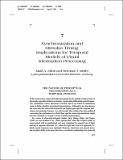Synchronization and stimulus timing: Implications for temporal models of visual information processing.

View/
Date
2004Author
Elliott, Mark
Metadata
Show full item recordUsage
This item's downloads: 338 (view details)
Recommended Citation
Elliott, M. A. & Müller, H, J. (2004). Synchronization and stimulus timing: Implications for temporal models of visual information processing. In C. Kaernbach, E. Schröger, & H. Müller (Eds.). Psychophysics beyond Sensation. Mahwah, NJ: Lawrence Erlbaum and Associates (pp. 137-156).
Abstract
In the visual system, objects and object groupings may be initially coded in terms of
physically separable attributes or features, representing differential spatial frequencies,
orientations, colors, directions of motion, and so on, which in combination
come to define wholistic perceptual representations. Although it has been known
for some time that visuocortical neurons can display quite specific response preferences
for particular features, it is only recently that evidence has been gathered
concerning the mechanisms by which these specific neural representations might
become combined or "bound" to form a unified representation.

